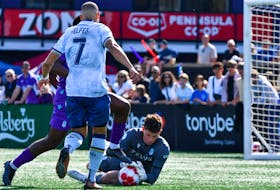Player safety is paramount and strict protocols have been established, but at the end of the day, rugby is a contact sport and there will be accidents.
“And most of these tragic things that have occurred are just an accident,” said Newfoundland and Labrador Rugby Union coaching director Simon Blanks, “where something goes completely off script, not unlike tragic accidents in hockey or American football or other contact sports.”
Blanks was speaking a couple of days after Brodie McCarthy, a Grade 12 student from P.E.I., died after being injured during a rugby game Friday evening at Three Oaks High School in Summerside.
McCarthy was a member of the Midget AAA Kings County Kings hockey team, but was playing with the Montague Regional High School’s rugby team, of which his twin brother was also a member, when he was injured during the game.
McCarthy was transported to Prince County Hospital in Summerside and then to Moncton, N.B., where he underwent surgery.
Following the surgery, the school’s website announced on Saturday that McCarthy did not register any brain activity and that his family had chosen to donate his organs.
McCarthy’s death came almost five years to the day 17-year-old rugby player Rowan Stringer of Ottawa died after suffering two concussions within a week.
Her death led to Ontario adopting “Rowan’s Law,” an act governing the management of youth concussions in all sports.
The latest tragedy will no doubt trigger a concern amongst parents of young rugby players who have a passion for a sport that is not for the faint of heart.
Rugby is very much a contact sport, and with that comes inherent risks, Blanks said.
"There’s no contact in rugby until after the age of 12. The kids play flag rugby to find out if they enjoy the actual non-contact aspects of the game. From there, there’s a graded integration into contact that’s as safe as we can possibly make it. They don’t go straight into full-bore rugby.”
Simon Blanks
But Blanks, who is co-coach of the Atlantic Rock Canadian Rugby Championship team, maintains the attention to detail to safe contact management in rugby is very high, “so high that a lot of American football teams — particularly those in college — are employing rugby coaches to teach their football kids safe tackle technique, which reduces the risks of concussions.”
Some rugby players wear headgear — padded scrum caps — that provide protection from cuts, abrasions and cauliflower ears, especially in scrums and rucks, but they are not designed to prevent concussions.
Nevertheless, Blanks said world rugby has a very strict protocol when it comes to concussion, or suspected concussions sustained.
“I think it’s been adopted — if not, it should be adopted — by all sports,” he said.
“If a kid even mentions to a referee, their coaches or physio people that they took a bang in the head and they feel dizzy, they’re removed from the game instantly and they can’t go back on the field for a minimum period of two weeks,” he said.
“It’s a week of complete rest, even for a minor, minor, minor head bump. These things are not taken lightly. Player safety is paramount, notwithstanding the fact it is a contact sport.”
So what would Blanks say to parents who are reluctant to sign up their kids in a minor rugby program, such as those run by Blanks’ Dogs Rugby Football Club and the Swilers?
“First of all, there’s no contact in rugby until after the age of 12,” he said. “The kids play flag rugby to find out if they enjoy the actual non-contact aspects of the game.
“From there, there’s a graded integration into contact that’s as safe as we can possibly make it. They don’t go straight into full-bore rugby. They’re taught safe tackle techniques, safe body position, they’re taught how to manage the ball into contact so that they don’t hurt themselves or their opponents.
“For tackling, you’re taught to safely manage a tackle so that you’re not vulnerable.”
Blanks points out a lesson that is taught to budding players, from the time they first touch the ball, “that in order to score, you have to avoid a tackle. You have to avoid contact, so we’re teaching the kids to not run into those vulnerable situations, but to run away from them.”








